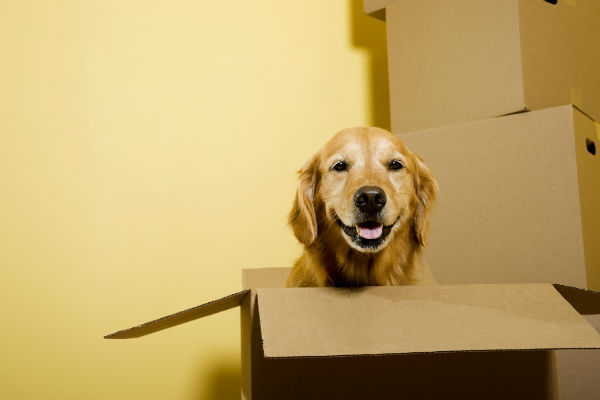
Much as we’d all like to think otherwise, moving is never a fun-filled party. But a move with dogs can be downright traumatic — for you and for your dog.
“Pets don’t really understand what’s happening, and it’s up to us to make them comfortable,” says Julie Hansen, a veterinarian and chair of veterinary technology at Argosy University in Eagan, Minn. But careful planning before, during, and after the move can make the experience easier on everyone. Here’s how to pull that off.
Prepare Your Dog for Change
This is easier said than done, but the best way to keep animals calm when moving is to stay calm yourself — or at least fake it and refrain from uncensored freak-outs in front of your pets, says Walter Woolf, a veterinarian and owner of Air Animal Pet Movers, which facilitates pet moves throughout the world.

Woolf advises clients to talk to their pets about the upcoming move, explain where they’re going, and what life will be like there. No, Rex won’t understand the actual words. But your calm voice will project calmness to your pet, Woolf says, setting a positive mood.
If your pet has never flown before, prepare him for the airplane ride by taking him through a car wash, which will simulate the sounds and motion of flight, Woolf says. Speak calmly to your pet while the water and brushes swish around your car.

Here are more ways to prepare your dog for the big move.
- A few days before the move, reduce Fido’s food servings by one-third, so he won’t have a full tummy when he’s rocking on a plane or bouncing in a car.
- Make sure dogs are microchipped and have ID tags with your new address on them. That way, if they escape during the move, they can easily be traced back to you.
- If you’re moving internationally, work with your veterinarian to find out what tests, vaccinations, paperwork, or inspections are required by your destination country. Some countries have a six-month waiting period between when the paperwork is filed and the animal is allowed into the country. Refer to the U.S. Department of Agriculture to learn more about international pet regulations.
- Assemble and tape some boxes several days before the move, so your dog becomes accustomed to the new look and sound of his home.
- If you’re transporting Fifi in a carrier, let her smell and inspect it before move day. Put her favorite blanket and treats in the carrier to make it a more positive experience.
- Get copies of your dog’s health records, so you can give them to your new veterinarian, and a health certificate, which is required by some states.
What to Do on Moving Day
Moving day is chaotic for dogs when they see strangers carting off their favorite furniture and familiar surroundings. If possible, arrange a dog playdate with a trusted friend or relative who can keep your dog out of harm’s way during the move. If that’s not possible, place the dog in a pet crate or quiet room where movers won’t go.
When it’s time to leave for your new home, pack your dog into the car last, so he won’t overheat. At first, cover the dog crate with a light blanket, so your dog won’t see the passing scenery, which can be frightening, according to PetFirst Pet Insurance. After a couple of hours, when your pooch has calmed down, you can remove the blanket.
Introducing Dogs to Their New Home
Before you let Humbert explore his new home, inspect it first to make sure no health hazards have been left behind, including cleaning products and rat poisons he can ingest, or holes in cabinets or walls where he can hide. Then open the crate, and let Humbert investigate at his leisure.

Dogs are curious animals, and most will dart out and madly sniff around their new home. Cats may be more reticent and take their time getting to know this strange place you’ve dragged them to, so be patient and don’t rush them.
When movers arrive with your belongings, segregate the dog again in a crate or a safe room. If possible, set up furniture in a familiar pattern, which will be less stressful for dogs and people, and re-establish a familiar feeding and potty schedule. In other words: If your dog is used to sleeping with you, don’t try to establish a new normal directly after a move — snuggle up and give your four-legged family member time to adjust.
By: Lisa Gordon
This article appeared first on “Real Estate News and Insights” from realtor.com.
Want more information on living with pets in your home? Get tips here.


